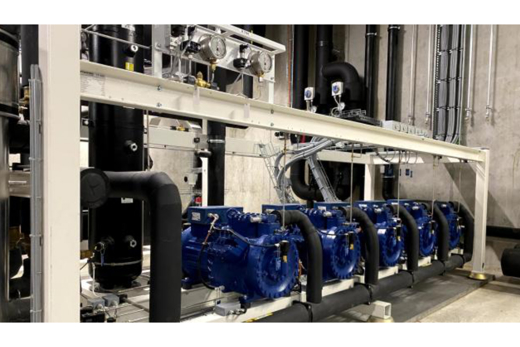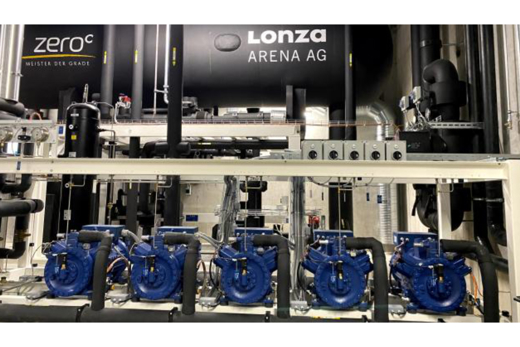Winning the cool game with eco-friendly ice rinks
While most ice hockey stadiums and skating rinks use ammonia refrigeration systems, the "Lonza Arena" in Visp operates a transcritical CO2 system with Bock compressors. One advantage is that the technology provides cooling for the ice rink and the air conditioning system as well as heat at a high temperature level. This has a positive effect on operating costs and makes further heat generators obsolete.
Ice rink and multi-purpose hall for energy city VISP
The town of Visp in the Swiss canton of Valais is an "energy town", which means it is committed to the efficient use of energy, climate protection and renewable energies. It was therefore a matter of course for the municipality to also comply with the minimum energy standard for the ice rink and multi-purpose hall, which was completed in the fall of 2019. A significant contribution to this is made by the technology that provides cooling and heating for the object with its 5,700 m² total area.

Hot on ice: Ice preparation also needs hot water
Cold is needed both for the ice surface and for air conditioning, heat is used for heating (via the component of the heating and ventilation technology) as well as for hot water preparation and - even if it seems paradoxical at first glance - for the maintenance of the ice surface. By preparing the ice surface with warm water, unevenness or traces of the skate blades are removed. For this purpose, the ice is briefly loosened by the warm water so that it can then freeze over to a mirror-smooth plane.
Waste heat utilization at a high temperature level
In order to cover the cooling and heating requirements efficiently, the municipality of Visp as investor and the Leplan office, which was commissioned with the general planning of the energy concept, decided on a transcritical CO2 plant with 600 kW cooling capacity.
An unusual decision, as most ice arenas use ammonia as a refrigerant and medium, but the choice of carbon dioxide has several advantages: First, unlike ammonia, the natural refrigerant CO2 is not irritating should a leak occur, and second, the transcritical system also generates heat at a sufficiently high temperature level for heating purposes and hot water production at the same time as the cold. It was therefore possible to dispense with additional heating sources for this ice rink.
Swiss planner with international experience
The Swiss company Zero-C in St-Pierre-de-Clages was commissioned with the planning and implementation of the refrigeration and heating technology. It had already gained a great deal of experience with transcritical CO2 systems, including - crucially for the project in Visp - with ice rinks.
These place special demands on the system when the refrigerant CO2 also evaporates in the cooling pipe coils under the ice rink. This is because the oil in the system must then also be recirculated from the rink's widely ramified pipe system.
Zero-C was able to demonstrate, among other things, know-how that the team had gained in 2012 during the implementation of the world's first transcritically built ice rink in Canada. This tipped the scales in the choice of engineering partner.

Low oil carry over rate of the Bock compressors advantageous
The oil management mentioned above is all the easier the less oil is entered into the entire system. Therefore, Zero-C ordered the core components of the transcritical system from Christof Fischer GmbH (Kernen im Remstal), a supplier known for systems based on Bock compressors. Bock CO2 compressors are highly regarded in the industry for their low oil carry over rate. Bock's decades of experience with transcritical CO2 systems and the high efficiency of the compressors also spoke in favor of Bock as a supplier.
Since the arena in Visp requires about 600 kW of cooling capacity, Zero-C had chosen five HGX46/440-4 ML CO2 T transcritical Bock compressors for the heart of the refrigeration center.

River water or deep water as a heat source or sink
If the heat demand is in the foreground, the CO2 refrigeration system - basically a reversible heat pump - can be used for heating purposes. Since cooling or heating requirements are rarely equal, an energy surplus or deficit can be compensated via the river water of the nearby Rhone. In exceptional cases, if the river water is too cold for effective heat pump operation, deep water can also be used.
A conventional gas cooler, as used in other transcritical plants to dissipate the excess heat to the ambient air, could be avoided with in this plant thanks to waste heat recovery and water cooling.
